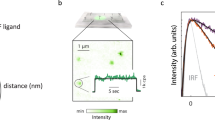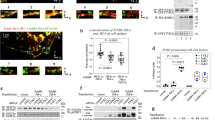Abstract
To our knowledge, no structural study to date has characterized, in an intact receptor, the coupling of conformational change in extracellular domains through a single-pass transmembrane domain to conformational change in cytoplasmic domains. Here we examine such coupling, and its unexpected complexity, using nearly full-length epidermal growth factor receptor (EGFR) and negative-stain EM. The liganded, dimeric EGFR ectodomain can couple both to putatively active, asymmetrically associated kinase dimers and to putatively inactive, symmetrically associated kinase dimers and monomers. Inhibitors that stabilize the active or inactive conformation of the kinase active site, as well as mutations in the kinase dimer interface and a juxtamembrane phosphorylation site, shift the equilibrium among the three kinase association states. This coupling of one conformation of an activated receptor ectodomain to multiple kinase-domain arrangements reveals previously unanticipated complexity in transmembrane signaling and facilitates regulation of receptor function in the juxtamembrane and cytoplasmic environments.
This is a preview of subscription content, access via your institution
Access options
Subscribe to this journal
Receive 12 print issues and online access
$189.00 per year
only $15.75 per issue
Buy this article
- Purchase on Springer Link
- Instant access to full article PDF
Prices may be subject to local taxes which are calculated during checkout





Similar content being viewed by others
References
Ogiso, H. et al. Crystal structure of the complex of human epidermal growth factor and receptor extracellular domains. Cell 110, 775–787 (2002).
Garrett, T.P. et al. Crystal structure of a truncated epidermal growth factor receptor extracellular domain bound to transforming growth factor α. Cell 110, 763–773 (2002).
Zhang, X., Gureasko, J., Shen, K., Cole, P.A. & Kuriyan, J. An allosteric mechanism for activation of the kinase domain of epidermal growth factor receptor. Cell 125, 1137–1149 (2006).
Li, S. et al. Structural basis for inhibition of the epidermal growth factor receptor by cetuximab. Cancer Cell 7, 301–311 (2005).
Cho, H.S. & Leahy, D.J. Structure of the extracellular region of HER3 reveals an interdomain tether. Science 297, 1330–1333 (2002).
Jura, N. et al. Mechanism for activation of the EGF receptor catalytic domain by the juxtamembrane segment. Cell 137, 1293–1307 (2009).
Red Brewer, M. et al. The juxtamembrane region of the EGF receptor functions as an activation domain. Mol. Cell 34, 641–651 (2009).
Shi, F., Telesco, S.E., Liu, Y., Radhakrishnan, R. & Lemmon, M.A. ErbB3/HER3 intracellular domain is competent to bind ATP and catalyze autophosphorylation. Proc. Natl. Acad. Sci. USA 107, 7692–7697 (2010).
Hunter, T., Ling, N. & Cooper, J.A. Protein kinase C phosphorylation of the EGF receptor at a threonine residue close to the cytoplasmic face of the plasma membrane. Nature 311, 480–483 (1984).
Morrison, P., Takishima, K. & Rosner, M.R. Role of threonine residues in regulation of the epidermal growth factor receptor by protein kinase C and mitogen-activated protein kinase. J. Biol. Chem. 268, 15536–15543 (1993).
Thiel, K.W. & Carpenter, G. Epidermal growth factor receptor juxtamembrane region regulates allosteric tyrosine kinase activation. Proc. Natl. Acad. Sci. USA 104, 19238–19243 (2007).
Mi, L.Z. et al. Functional and structural stability of the epidermal growth factor receptor in detergent micelles and phospholipid nanodiscs. Biochemistry 47, 10314–10323 (2008).
Lu, C. et al. Structural evidence for loose linkage between ligand binding and kinase activation in the epidermal growth factor receptor. Mol. Cell. Biol. 30, 5432–5443 (2010).
Heisermann, G.J. & Gill, G.N. Epidermal growth factor receptor threonine and serine residues phosphorylated in vivo. J. Biol. Chem. 263, 13152–13158 (1988).
Heisermann, G.J. et al. Mutational removal of the Thr669 and Ser671 phosphorylation sites alters substrate specificity and ligand-induced internalization of the epidermal growth factor receptor. J. Biol. Chem. 265, 12820–12827 (1990).
Wood, E.R. et al. A unique structure for epidermal growth factor receptor bound to GW572016 (Lapatinib): relationships among protein conformation, inhibitor off-rate, and receptor activity in tumor cells. Cancer Res. 64, 6652–6659 (2004).
Stamos, J., Sliwkowski, M.X. & Eigenbrot, C. Structure of the epidermal growth factor receptor kinase domain alone and in complex with a 4-anilinoquinazoline inhibitor. J. Biol. Chem. 277, 46265–46272 (2002).
Yun, C.H. et al. Structures of lung cancer-derived EGFR mutants and inhibitor complexes: mechanism of activation and insights into differential inhibitor sensitivity. Cancer Cell 11, 217–227 (2007).
Eck, M.J. & Yun, C.H. Structural and mechanistic underpinnings of the differential drug sensitivity of EGFR mutations in non-small cell lung cancer. Biochim. Biophys. Acta 1804, 559–566 (2010).
Yun, C.H. et al. The T790M mutation in EGFR kinase causes drug resistance by increasing the affinity for ATP. Proc. Natl. Acad. Sci. USA 105, 2070–2075 (2008).
Sorokin, A. Activation of the EGF receptor by insertional mutations in its juxtamembrane regions. Oncogene 11, 1531–1540 (1995).
Hackel, P.O., Gishizky, M. & Ullrich, A. Mig-6 is a negative regulator of the epidermal growth factor receptor signal. Biol. Chem. 382, 1649–1662 (2001).
Zhang, X. et al. Inhibition of the EGF receptor by binding of MIG6 to an activating kinase domain interface. Nature 450, 741–744 (2007).
Carpenter, G. & Cohen, S. 125I-labeled human epidermal growth factor. Binding, internalization, and degradation in human fibroblasts. J. Cell Biol. 71, 159–171 (1976).
Honegger, A.M. et al. Point mutation at the ATP binding site of EGF receptor abolishes protein-tyrosine kinase activity and alters cellular routing. Cell 51, 199–209 (1987).
Huang, F., Kirkpatrick, D., Jiang, X., Gygi, S. & Sorkin, A. Differential regulation of EGF receptor internalization and degradation by multiubiquitination within the kinase domain. Mol. Cell 21, 737–748 (2006).
Geyer, C.E. et al. Lapatinib plus capecitabine for HER2-positive advanced breast cancer. N. Engl. J. Med. 355, 2733–2743 (2006).
Ludtke, S.J., Baldwin, P.R. & Chiu, W. EMAN: semiautomated software for high-resolution single-particle reconstructions. J. Struct. Biol. 128, 82–97 (1999).
Frank, J. et al. SPIDER and WEB: processing and visualization of images in 3D electron microscopy and related fields. J. Struct. Biol. 116, 190–199 (1996).
Acknowledgements
This work was supported by US National Institutes of Health grant HL-48675. L.-Z.M., C.L. and T.A.S. thank J. Kuriyan for hosting them in 2004–2005 when experiments that eventually led to this work were initiated.
Author information
Authors and Affiliations
Contributions
L.-Z.M. prepared constructs, designed and carried out experiments, and wrote the manuscript. C.L. prepared constructs, designed and carried out experiments, and discussed the writeup. N.N. performed early EM experiments. Z.L. trained N.N. and L.-Z.M., and maintained and supervised the EM facility. T.W. discussed and supervised EM experiments and strategy, wrote the manuscript, and helped respond to referees. T.A.S. designed the overall experimental approach, supervised experiments, wrote the manuscript and responded to referees.
Corresponding author
Ethics declarations
Competing interests
The authors declare no competing financial interests.
Supplementary information
Supplementary Text and Figures
Supplementary Figures 1–12 (PDF 10554 kb)
Rights and permissions
About this article
Cite this article
Mi, LZ., Lu, C., Li, Z. et al. Simultaneous visualization of the extracellular and cytoplasmic domains of the epidermal growth factor receptor. Nat Struct Mol Biol 18, 984–989 (2011). https://doi.org/10.1038/nsmb.2092
Received:
Accepted:
Published:
Issue Date:
DOI: https://doi.org/10.1038/nsmb.2092
This article is cited by
-
Oligomeric organization of membrane proteins from native membranes at nanoscale spatial and single-molecule resolution
Nature Nanotechnology (2024)
-
In-cell structural dynamics of an EGF receptor during ligand-induced dimer–oligomer transition
European Biophysics Journal (2020)
-
The Dipole Potential Modifies the Clustering and Ligand Binding Affinity of ErbB Proteins and Their Signaling Efficiency
Scientific Reports (2016)
-
The juxtamembrane regions of human receptor tyrosine kinases exhibit conserved interaction sites with anionic lipids
Scientific Reports (2015)
-
Ligand regulation of a constitutively dimeric EGF receptor
Nature Communications (2015)



